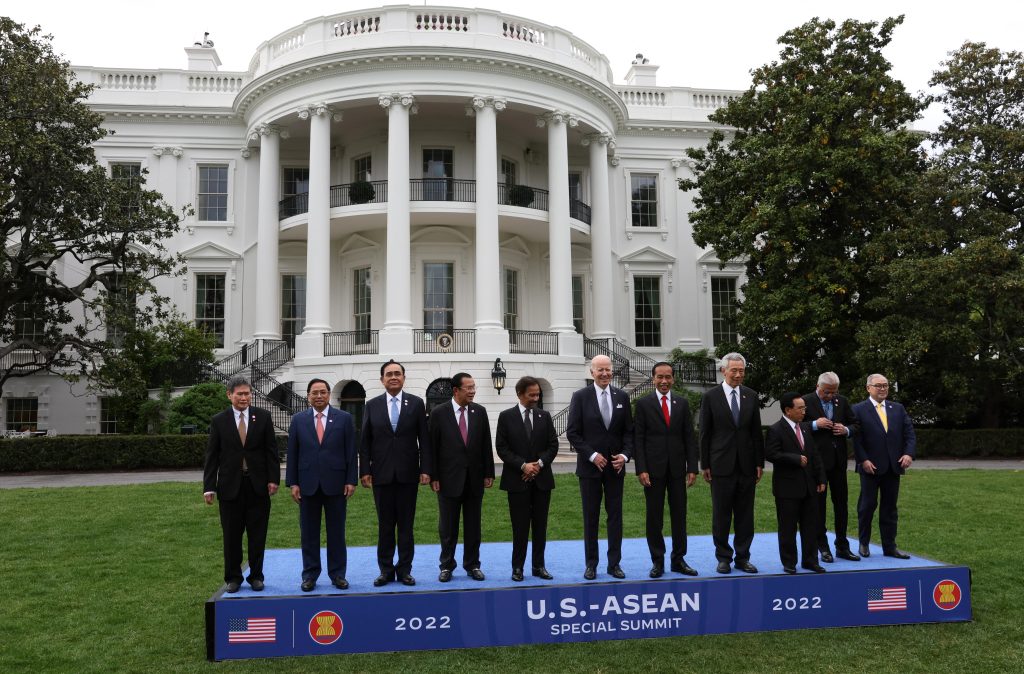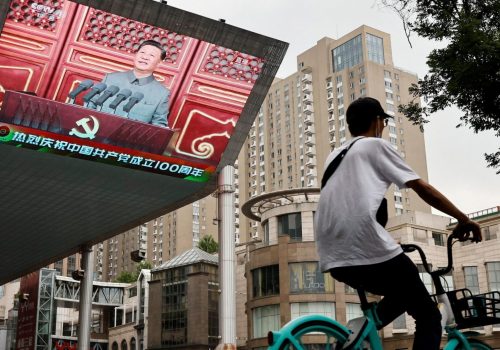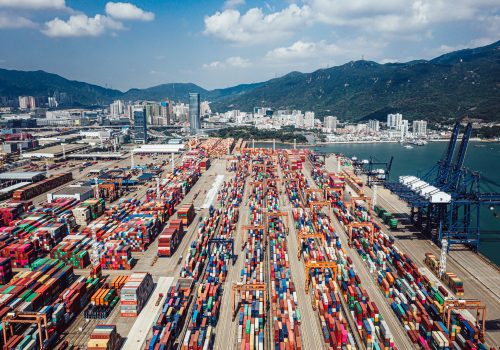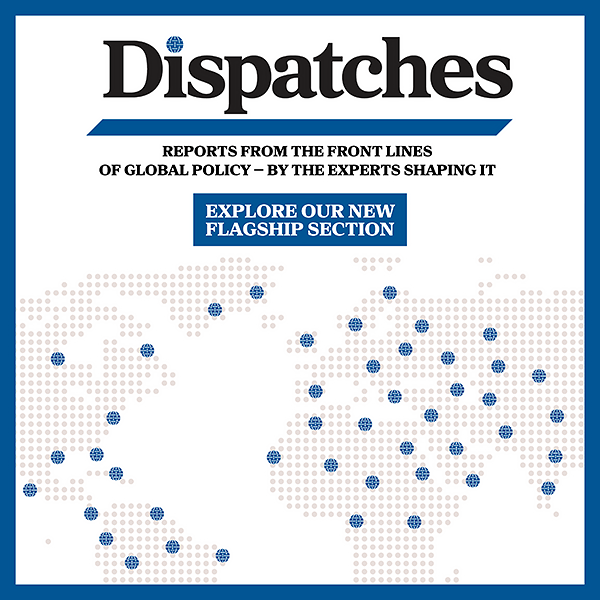During his planned visit to Japan at the end of May, US President Joe Biden is expected to formally launch the Indo-Pacific Economic Framework (IPEF), the centerpiece of his administration’s economic policy toward the region. Announced at the East Asia Summit in October 2021, the framework is the United States’ first attempt to create a large-scale, multilateral, Asia-focused economic strategy since the Trump administration withdrew from the Trans-Pacific Partnership (TPP) in 2017.
Though specific details about the framework have yet to be announced, the administration has said the IPEF will have four pillars: (1) fair and resilient trade; (2) supply chain resilience; (3) infrastructure, clean energy, and decarbonization; and (4) tax and anti-corruption. However, the administration has made clear that the deal will not take the form of a “traditional trade agreement.” They have signaled that the framework will not offer tariff cuts and other market-access tools, the usual focus area of US trade agreements. In previous trade deals such as the TPP, Washington used the prospect of increased market access to incentivize partners to accept policies that could run counter to their immediate economic interests. Without them, the framework runs the risk of being perceived by regional partners, particularly emerging economies, as a list of policy requests with few tangible benefits.
This is especially true if the US wants to also prioritize nations beyond traditional regional interlocutors such as Australia, Japan, South Korea, New Zealand, and Singapore, which are already largely aligned with the United States on the rules, standards, and norms for the issues the IPEF will likely focus on. The inclusion of other regional economies, especially the large emerging markets of the Association of Southeast Asian Nations (ASEAN), a political and economic union of ten nations in Southeast Asia, will be necessary to build a comprehensive economic framework that can influence the overall region. For large, developing nations– like Vietnam, Indonesia, and Thailand– to see value in signing on to the framework, the US must offer clear benefits that align with their priorities. A recent survey of these emerging economies found trade facilitation to be one of the areas of great interest in the agreement. In order to effectively incentivize developing economies’ participation in IPEF, the US should place particular focus on the trade facilitation chapters of the framework under the fair and resilient trade pillar. If the United States can facilitate a successful arrangement surrounding the trade facilitation portions of the framework, it will help towards building a broader economic partnership in the region.
Trade Facilitation
Trade facilitation broadly refers to policies that target administrative barriers impeding trade. In practice this usually means improving the efficiency of existing trade regulations, implementing new technologies relevant to trade (such as a National Single Window), and addressing emerging structural changes in trade. Trade facilitation targets the operational hurdles to trade and reduces the compliance costs traders shoulder when they engage with governments. The gains accessed through effective trade facilitation arrangements, such as the World Trade Organization’s (WTO) 2017 Trade Facilitation Agreement (TFA), are equivalent to sizable tariff line reductions. For example, the implementation of the WTO’s TFA is forecasted to slash members’ trade costs by an average of 14.3%.
Trade facilitation has also been a key priority of the region. For the past two decades, trade facilitation has been a standing policy priority for ASEAN. It has been a continuous agenda item in all ASEAN Economic Community (AEC) Blueprints, including the active one ending in 2025. The AEC Blueprint 2025 defines ASEAN’s current trade facilitation goals as achieving “convergence in trade facilitation regimes amongst the member states and to move closer to the global best practice.” In service of these goals, the United States should specifically prioritize improving the region’s import and customs administration efficiency and integrity. In addition to the increased connectivity and trade between the United States and the region brought about by such policies, the United States can also provide trade facilitation support in exchange for political capital or implicit concessions in the other areas it aims to influence regional standards. The US can specifically focus on policies such as Trusted Trader Programs and technical assistance for a country’s National Single Window.
Trusted Trader Programs
One policy that Washington can include in the IPEF to support the Indo-Pacific region and enhance mutual economic connectivity is Authorized Economic Operator (AEO)/Trusted Trader programs. AEO programs certify market participants in a nation’s customs administration as trustworthy. They do this by verifying that the authorized participant maintains an adequate level of supply chain security so that the customs screenings for exports and imports can be expedited. In the United States the program is known as the Customs Trade Partnership Against Terrorism (CTPAT). For AEO program participants, exporting is often cheaper and quicker than those not in the program, making it an important part of trade facilitation. Although all major economies in the region already maintain some form of an AEO Program, many are limited in scope or have not responded to new changes in the global trading landscape such as the rise of e-commerce. The United States can work with regional partners to expand AEO programs to incorporate digital economy participants.
The United States should also prioritize the expansion of AEO Mutual Recognition Arrangements (MRAs) which help unify AEO Programs across different nations such that participants in one nation’s program can seamlessly access the benefits associated with accreditation under the other nations’ program. The United States currently has such agreements with Japan, New Zealand, Korea, Taiwan, and Singapore, but negotiations with ASEAN and major US-trading partners such as Malaysia, Thailand, Vietnam, and the Philippines should be prioritized. Though the United States traditionally negotiates bilateral MRAs, the Pacific Alliance’s MRA, the first multilateral MRA globally, presents one alternative model to follow. It could more seamlessly link the United States and the region as a whole. MRAs between the United States and its regional partners would be especially impactful for small and medium-sized enterprises (SMEs). Unlike multinationals which may have offices in every nation they export to, SMEs may not have the capacity to register as an AEO for any nation beyond their home nation. An MRA would allow them access to some of the same benefits as larger multinationals.
A regional MRA would need to go hand in hand with capacity building for local customs agencies. A prerequisite for any MRA with the United States is that the partner country can meet the United States’ established set of security requirements. As a result, it will be important for the United States to provide training, share best practices, and facilitate the transfer of new customs technology to ensure its partners can meet the US’ specifications.
A National Single Window (NSW)
Another important policy area the United States ought to focus on in the IPEF is providing support to operationalize or enhance regional National Single Windows (NSW). A NSW is a trade facilitation platform that allows international traders to submit all information needed in a standardized format to one government agency to obtain the required papers, permits, and clearances to complete their import or export processes. NSWs are a key bureaucratic innovation. Prior to their implementation, traders would often have to deal with multiple agencies across government which each have separate, but sometimes overlapping, requirements making the import and export process both convoluted and time-consuming. The successful implementation of a NSW has tangible impacts on that country’s trade regime. The United States, for example, estimated that its own NSW, the Automated Commercial Environment, generated nearly $1.8 billion in processing efficiencies in FY2020.
US engagement on NSW policy issues in the IPEF would build on the work the United States has already done, namely through USAID, to develop the blueprints for the implementation of regional partners’ NSWs. Regional nations’ NSWs are at different stages of development, so impactful support will look different in each case. For Cambodia and Laos, whose NSWs are still in the nascent stages of implementation, meaningful support would focus on further operationalizing and undertaking regulatory impact assessments to review and minimize any adverse byproducts or oversights of the NSW. For nations further along in their NSW development such as Malaysia’s uCustoms, Singapore’s Networked Trade Platform, or Thailand’s Customs 4.0, effective assistance could focus on supporting their efforts to build higher-performing, integrated, and client-focused systems, including trade logistics integration.
For those nations with the most advanced NSW, such as Malaysia and Thailand, the United States should also propose exploring Single Window connectivity wherein participating nations integrate their respective NSWs to further unify, streamline, and automate cross-border trade administrative processes. The US Customs and Border Protection and Singapore Customs are already exploring Single Window connectivity through a letter of intent signed in late 2020. Even in cases in which Single Window connectivity may not be possible in the short run, the United States should still pursue government-to-government data sharing arrangements to ensure efficient and secure trade flows between the United States, its regional partners, and both nation’s customs officials.
An Inclusive Regional Framework
For the United States to ensure its IPEF does not mature into a framework limited to like-minded nations, the United States should focus attention on the region’s large and emerging economies such as Thailand, Indonesia, and Vietnam. Targeted support for each of these nations’ respective trade facilitation priorities is one way to encourage their participation in the overarching framework.
Thailand already has an incredibly robust trade facilitation regime, so options for US assistance are limited. Nevertheless, the United States can help it address private sector concerns regarding its NSW. For example, it can support direct integration of its private sector with other government forms rather than just providing traders the website links to access them. It can also add electronic payment and self-certification systems to the NSW. Furthermore, Washington can support Thailand’s efforts to add translations to transit and customs procedures, which are currently only available in the local Thai language.
Indonesia also has an advanced trade facilitation regime but, similar to Thailand, the United States can make marginal improvements to its NSW and undertake impact assessments of the NSW on trade, particularly for SMEs. The United States can also support Indonesia in deploying technology to allow for a fully paperless environment with electronic processing of trade documents.
Vietnam’s trade facilitation regime is far less developed, so there are more opportunities for targeted US support. In Vietnam, imported goods are subject to more than 300 legal documents which are issued and maintained by separate government agencies. For traders to comply with these complex trade regulations, they must dedicate significant resources and time which can be especially impactful and sometimes prohibitive for SMEs.
The United States can also support Vietnam’s NSW development. One option is that the United States can assist in efforts to harmonize risk management practices for customs clearance across Vietnam’s relevant major agencies. Traders still report finding it complex and time-consuming to fulfill disparate ministries’ excessive administrative procedures, especially in relation to customs clearance. Any support the United States can provide in enhancing transparency, simplifying and harmonizing procedures, and modernizing customs would be especially beneficial to Vietnam’s NSW implementation and would be in line with policy mandates consistently pursued by the Vietnamese government.
Another possible point of engagement between the United States and Vietnam is the completion of a domestic non-tariff measures (NTMs) database and a repository of best practices in trade facilitation. Despite a longstanding effort from Vietnamese Customs Authorities, the NTM database and trade practices repository does not work properly and contains outdated and obsolete information.
Many of these issues are not unique to Thailand, Indonesia, and Vietnam. As a result, although the IPEF should prioritize these nations’ concerns and goals within the trade facilitation sections of the framework, the United States should also include other regional partners interested in building and implementing the same or similar policies.
Though trade facilitation is an important tool to secure developing economies’ participation in the IPEF, it cannot work alone. The US must provide other, substantial benefits such as partnerships to develop more resilient supply chains, infrastructure funding, and support for a renewable energy transition. Nevertheless, trade facilitation can be an impactful policy priority for the framework and sends an important signal to possible partners that the United States is listening to their priorities and is willing to incorporate their interests into the IPEF and support them on it.
Niels Graham is an assistant director with the GeoEconomics Center
Image: U.S. President Joe Biden poses for a group photograph with leaders from the Association of Southeast Asian Nations (ASEAN) during a special U.S.-ASEAN summit at the White House in Washington, U.S., May 12, 2022. REUTERS/Leah Millis



